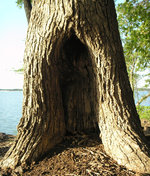DrTolhur
Mame
I like the look of trees with large hollows, like the one attached or even all the way up the trunk. It's just a cool and unexpected presentation of a tree. But I also work mostly with Japanese maples, and I know that they're typically considered more elegant than rugged, so people don't usually go this route with their design. I'm interested in possibly artificially creating a large hollow in one of my Japanese maples (at some point), but I'm curious if anyone has done it. Obviously there's plenty of content out there for other varieties, but I'm wondering if no one does it with Japanese maples just because people don't think it goes with the aesthetic or if there's some horticultural reason it doesn't work well. Feel free to share photos and experiences if you've ever tried it.










